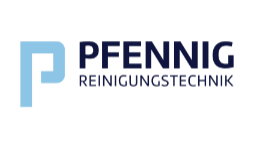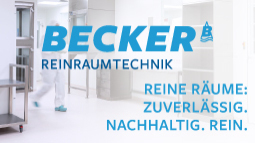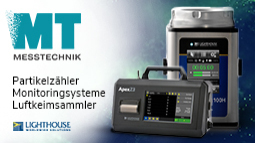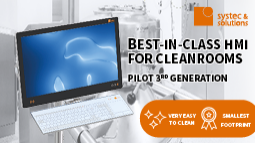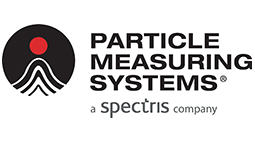Modular Cleanroom Construction Makes the Difference at St. Georges Hospital
The completion of a 408m2 major new aseptic pharmacy unit for the St Georges Hospital NHS Trust, London, UK is a significant example of the benefits of using modern modular construction techniques compared to a traditional cleanroom build. At every stage; from concept through project planning to final completion, the use of modules proved to be the most appropriate for the task.
The result is a superb advanced new facility featuring the latest equipment that the customer is delighted with and proud to show to other Hospital Pharmacies throughout the UK & Internationally. The project was completed on time with minimal disturbance and the final cost was within budget with a projected saving of 5% compared to other methods.Site Selection & PreparationMost Estates Departments recognise the problem of locating a new unit within a limited site, and in close proximity to existing resources and this was no exception. A suitable location was identified above an existing lightwell, however the existing structure was not designed to support a new building on this scale.In addition, access to the site was severely restricted because it was almost completely surrounded by buildings up to six storeys high, housing many of the main hospital functions. Disruption to these services would have had a dramatic impact on the operational capability of this major teaching hospital.Choice of Modular Cleanroom SolutionFaced with the many restrictions to the site, the Trust and Clean Modules quickly realised traditional cleanroom building methods would be impractical. Consequently a solution constructed from fourteen steel modules set on a critical load bearing steel frame was developed, which had a number of advantages. The modular construction provided a lightweight but rigid structure which could be prefabricated off-site and moved into position with the minimal amount of disruption to patients, staff, emergency services and public transport. The open modules also provided a versatile space into which the state-of-the art new cleanrooms could be created without the usual size limitations imposed by portable buildings. This framework had another advantage in that existing air handling units could be re-located easily and additional units accommodated efficiently.
Precision Timing & Minimal DisruptionRestricted loads in London and no blocking of hospital routes, especially Accident & Emergency, meant the delivery of the prefabricated components, manufactured at a remote location, was only possible over two weekends, set six weeks apart. Each lift on to site involved a massive three-part crane with 60m extension, which could only operate in calm weather and took several hours to assemble before it was operational.Achievement of this feat required military-like project planning to get the fleet of thirty two articulated lorries into position on time and in the correct order with no waiting allowed at the hospital itself. During the lifts, there was a strong co-ordinated effort between the 10-strong Clean Modules installation team and Trust.Safety FirstSafety was paramount, and the planning phase demanded a detailed Health & Safety risk assessment, particularly during the two lifts. As a result a strict lift route was developed with areas underneath, including wards and a canteen, closed during the transfer. This was carefully marshalled to prevent any personnel movement whilst materials were overhead.Outside, the Metropolitan Police and London Transport were involved with temporary diversion of bus routes and traffic as first the crane arrived, followed by the precisely timed arrival of the lorry fleet.
Versatile Cleanroom LayoutThe cleanroom design itself had to accommodate up to fifty staff and the range of different workflows and quality constraints needed in aseptic pharmaceutical preparation. Again the modular framework enabled the internal space to be utilised to the maximum even with a limited single access point to the facility.A good example of the flexible space benefits of using the modular construction is seen in the main Command and Preparation Room and GMP Grade D Aseptic Unit, which are 12.2m x 6.5m and 10.5m x 6.5m respectively. The rooms’ widths are nearly double what could have been achieved with a straightforward mobile building solution. This gave the Pharmacy Department the space to install the latest Grade A isolator technology in the form of nine Amercare and La Calhene isolator cabinets with Clarus hydrogen peroxide generators and rapid gassing ports. The open layout of the Aseptic Unit and the carefully planned layout of the Command Centre and interconnecting hatches between the two means the facility will be able to cope with the expected growth in demand over the next decade. In addition to the main unit, the facility also features a complete Grade D Cytotoxic Cleanroom Suite, which contains three isolators for the preparation of cancer drugs specific to each patient. In support of these main production areas, change areas, storage, preparation, checking and cleaning have all been taken into account with dedicated locations created for each.
Advanced Aseptic FacilityThe external appearance of the new facility is clean and modern, making use of a 0.5m2 silver grey Trespa cladding integrated perfectly with the window layout to create smooth lines minimise the impact on the surrounding structures.Inside, the Aseptic Unit benefits from one of the first rapid gassing hydrogen peroxide sterilisation units installed in an NHS hospital. This enables the latest efficient production methods to be deployed, raising standards and the capacity to meet growing demands.The new unit also uses an advanced facility management system that is capable of continuous monitoring of temperature, humidity, room pressures, and particles as well as other equipment and storage fridges, with a remote alarm links. This system is fully validated to the FDA CFR 21 Part 11 and GAMP 4 standards required for all pharmaceutical systems. The FMS is linked to the hospital management system and provides local and remote alarms and logging. Overall control of the air system is provided by the Hospital Trend controls.Commenting on the new facility, Phillip Gent, QA Manager said: “Without Clean Modules, we would have struggled to build the facility, which we desperately needed to expand our services to the hospital. Their modular solution really made the difference and we are delighted with the results. John Robinson, MD of Clean Modules remarked: “St Georges represented many of the challenges we face when planning every cleanroom build, but the scale of difficulty was exceptional. For us, this unit provides a fantastic example of where modular construction wins over traditional construction. We are proud to have achieved this result quickly, without disrupting the hospital, and within budget.”Clean Modules specialise in the design, construction and project management of Clean Room installations, controlled environments, clean-air and conditioning systems. In addition to specialist container cleanrooms, the company has considerable expertise in pharmaceutical, medical, hospital, and biotechnology applications.
